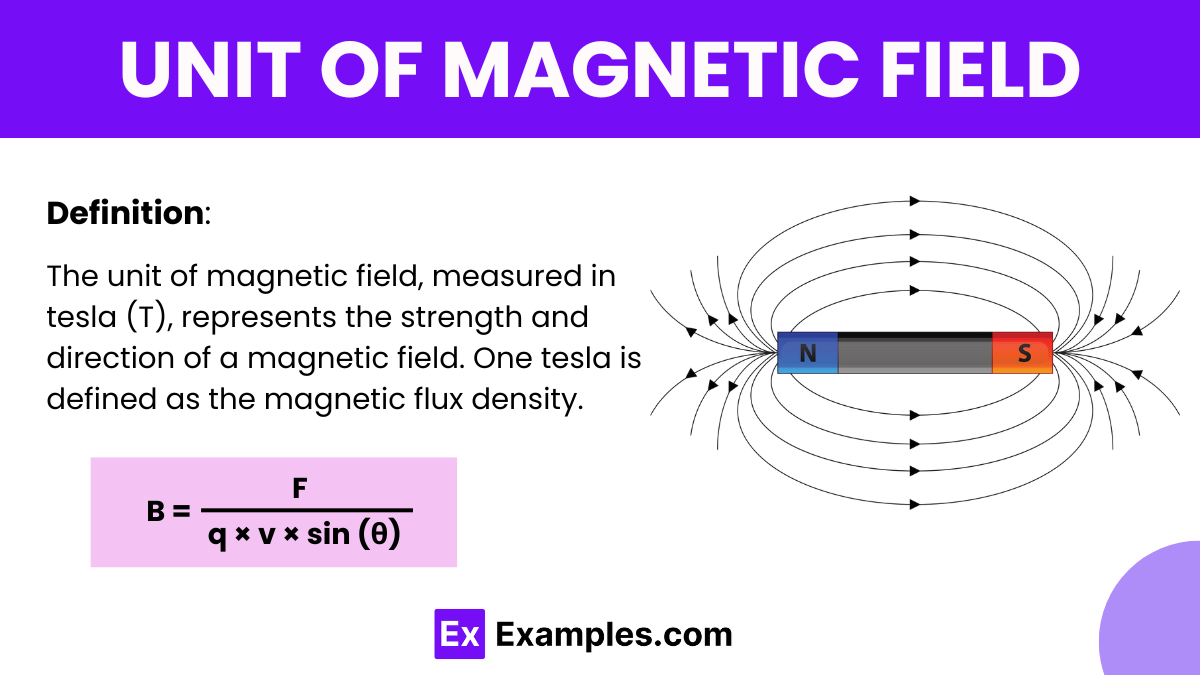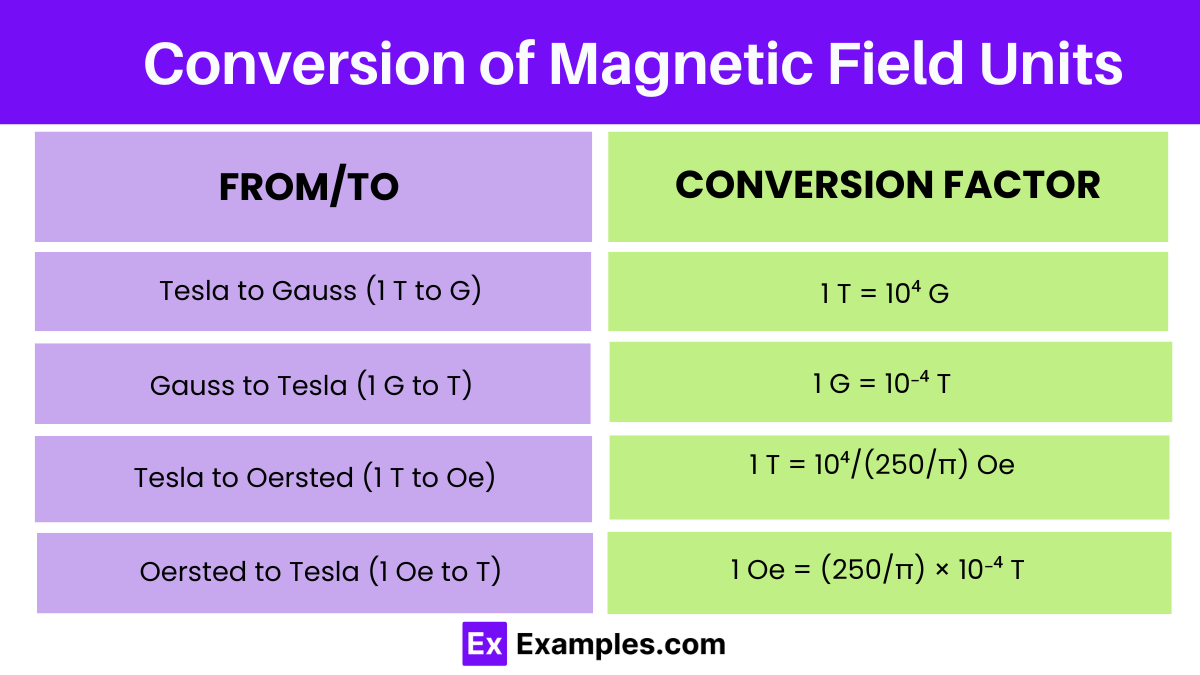What is the SI unit of the magnetic field?
Tesla
Gauss
Newton
Joule


Unit of magnetic field measure the strength and direction of magnetic fields, essential in understanding electromagnetic phenomena and their applications. These unit encompass various scales, from the microscopic realm of atomic spins to the cosmic scale of interstellar magnetic fields. By quantifying magnetic fields, scientists and engineers can comprehend and manipulate phenomena ranging from the Earth’s magnetic field to magnetic materials’ behavior in technological devices.
Where:
The Tesla (T) is the standard unit of magnetic field strength in the International System of Unit (SI). One Tesla is equivalent to one Newton per Ampere per meter (N/A·m). It represents the strength of a magnetic field experienced by a unit charge moving at a velocity of one meter per second perpendicular to the field, resulting in a force of one Newton. The Tesla is commonly used in physics, engineering, and various scientific disciplines to quantify magnetic fields in different applications, ranging from electronics and magnetism to geophysics and astrophysics.
The Gauss (G) is a unit of magnetic field strength in the CGS system, which stands for Centimeter-Gram-Second. One Gauss is equal to one Maxwell per square centimeter (Mx/cm^2), where a Maxwell is the unit of magnetic flux.
In practical terms, the Gauss measures the intensity of a magnetic field. For example, a refrigerator magnet typically has a magnetic field strength of a few hundred Gauss, while Earth’s magnetic field at its surface is approximately 0.5 Gauss.
The Gauss is commonly used in various fields such as magnetism, geophysics, and materials science to quantify magnetic fields in different applications.
The intensity of magnetic field is typically measured using unit such as Tesla (T) in the International System of Unit (SI), or Gauss (G) in some contexts. These unit quantify the strength of magnetic fields, aiding in various scientific and engineering applications, from magnetism research to medical imaging.
| Unit | Symbol | Equivalent to |
|---|---|---|
| Tesla (T) | T | 1 T = 1 N/(A·m) |
| Gauss (G) | G | 1 G = 10⁻⁴ T |
| Oersted (Oe) | Oe | 1 Oe = 250/(π A/m) |
| Weber per square meter (Wb/m²) | Wb/m² | 1 Wb/m² = 1 T |
| Kilogauss (kG) | kG | 1 kG = 10⁻¹ T |
| Millitesla (mT) | mT | 1 mT = 10⁻³ T |
| Microtesla (μT) | μT | 1 μT = 10⁻⁶ T |
The Tesla is the SI unit of magnetic field strength. One Tesla is equivalent to one Newton per Ampere per meter (N/A·m), representing the magnetic flux density. It is commonly used in scientific and engineering applications.
The Gauss is a unit of magnetic induction, named after Carl Friedrich Gauss. One Gauss is equal to 10⁻⁴ Tesla. It is often used in older literature and some specialized applications, particularly in the field of magnetism.
The Oersted is a unit of magnetic field strength in the centimeter-gram-second (cgs) system. One Oersted is equivalent to 250/(π A/m) or approximately 79.5775 A/m. It is primarily used in magnetic materials science and some engineering applications.
The Weber per square meter is a unit of magnetic flux density. One Weber per square meter is equivalent to one Tesla. It represents the total magnetic flux passing through a unit area perpendicular to the magnetic field.
The Kilogauss is a unit of magnetic induction equal to 10⁻¹ Tesla or 100 Gauss. It is often used in applications where magnetic fields are relatively strong, such as in magnetic resonance imaging (MRI) and magnetic separation.
The Millitesla is a subunit of the Tesla, equal to one-thousandth of a Tesla or 10⁻³ Tesla. It is commonly used to express magnetic field strengths in smaller scales, such as in laboratory experiments and measurements.
The Microtesla is another subunit of the Tesla, equal to one-millionth of a Tesla or 10⁻⁶ Tesla. It is used to measure very weak magnetic fields, such as those encountered in Earth’s magnetic field or magnetic field surveys.

| Conversion | Conversion Factor | Example |
|---|---|---|
| Tesla to Gauss (1 T to G) | 1 T = 10⁴ G | 10 T = 10⁵ G |
| Gauss to Tesla (1 G to T) | 1 G = 10⁻⁴ T | 10 G = 10⁻³ T |
| Tesla to Oersted (1 T to Oe) | 1 T = 10⁴/(250/π) Oe | 10 T = 10⁵/(250/π) Oe |
| Oersted to Tesla (1 Oe to T) | 1 Oe = (250/π) × 10⁻⁴ T | 10 Oe = (250/π) × 10⁻³ T |
Magnetic field units find extensive use in various fields, including electronics, materials science, medical imaging, and geophysics.
Magnetic fields vary widely in strength, from minute fields in everyday objects to immense fields in celestial bodies. Having multiple units like Tesla, Gauss, and Oersted allows scientists and engineers
Magnetic fields permeate the cosmos, influencing celestial bodies, galaxies, and the interstellar medium. Units like Tesla, Gauss, and Oersted facilitate the study of cosmic magnetism, helping astronomers unravel mysteries such as the origin of magnetic fields
Text prompt
Add Tone
10 Examples of Public speaking
20 Examples of Gas lighting
What is the SI unit of the magnetic field?
Tesla
Gauss
Newton
Joule
What unit is commonly used to measure smaller magnetic fields?
Tesla
Gauss
Henry
Ampere
How is 1 Tesla defined in terms of magnetic flux density?
1 T = 1 Wb/m²
1 T = 1 Wb/m
1 T = 1 N/A
1 T = 1 J/m²
Which of the following units is not used to measure magnetic fields?
Tesla
Gauss
Weber
Coulomb
What is the CGS unit of the magnetic field?
Tesla
Gauss
Weber
Henry
How many Gauss are there in 1 Tesla?
1,000 Gauss
10,000 Gauss
100 Gauss
1 Gauss
Which unit is used to measure the magnetic flux?
Weber
Tesla
Gauss
Ampere
What is the relationship between Tesla and Weber?
1 T = 1 Wb
1 T = 1 Wb/m
1 T = 1 Wb/m²
1 T = 1 Wb/m³
Which instrument is used to measure the magnetic field strength?
Voltmeter
Ammeter
Magnetometer
Ohmmeter
How is the unit Tesla derived in terms of base SI units?
kg·m/s²·A
kg/(A·s)
kg/(s·A)
kg/(s²·A)
Before you leave, take our quick quiz to enhance your learning!

